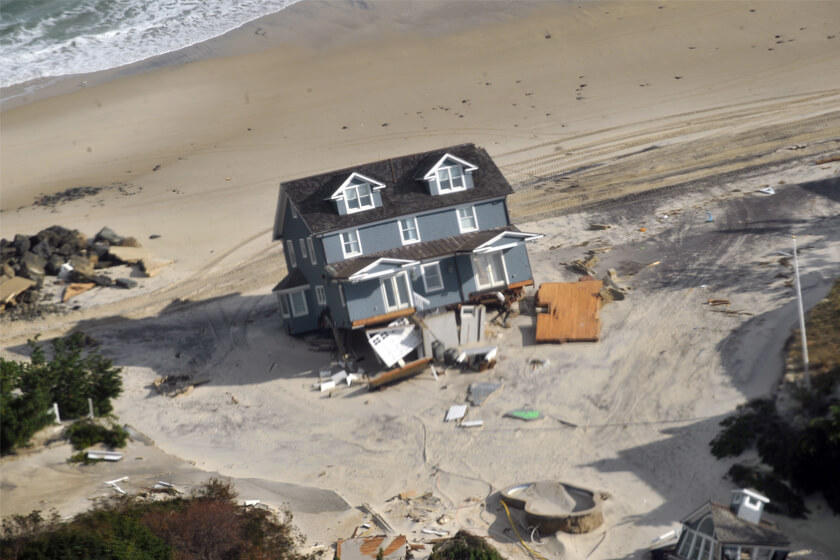West Long Branch, NJ – It has been five years since Superstorm Sandy made landfall on New Jersey’s coast. While life has returned to normal for many, others continue to struggle with the devastation caused by the storm. The Monmouth University Poll has been tracking some of the Garden State’s hardest hit residents – those who suffered significant property damage from the storm or were displaced from their homes – in its Superstorm Sandy Panel study. With the 5 th anniversary of Sandy approaching, 432 participants from the original 2013 survey agreed to share their current experiences with Monmouth. A majority remain dissatisfied with New Jersey’s recovery efforts, most report that their family’s financial situation has yet to bounce back, and some still face hurdles dealing with the state’s rebuilding assistance program.
The number of Superstorm Sandy Panel participants who are dissatisfied with New Jersey’s recovery efforts has declined from 67% in 2013 to 55% today, but this means a majority remain unhappy with the state five years after the storm’s devastation. Specifically, 29% of these hard-hit residents are currently very dissatisfied and 26% are somewhat dissatisfied. Only 9% are very satisfied with the recovery effort and another 35% are somewhat satisfied. Among those who have been able to move back to their Sandy damaged properties, 50% are satisfied with the state’s efforts. Among those who have permanently relocated or are still waiting to move back, just 29% are satisfied with the state.
Just under half of the survey’s participants (44%) say the state’s recovery efforts are focused on helping people like them, which is much more positive than in 2013 (24%). Still, a majority of 56% say that people like them have been forgotten in the recovery effort. Although the panel is not a scientific sample representative of all New Jersey Sandy victims, the results illustrate the challenges many continue to face.
“Monmouth has been tracking some of New Jersey’s hardest hit Sandy victims for nearly five years and it is clear that the slow rate of recovery is something many will never be able to get over,” said Patrick Murray, director of the independent Monmouth University Polling Institute. “We have certainly seen some improvement in these residents’ attitudes. But with nearly 1-in-10 of those surveyed still waiting to return home, it is unlikely that a majority of Sandy victims will ever be satisfied with how New Jersey has handled the recovery.”
About 3-in-4 panel participants have returned to their pre-Sandy properties, including 18% who had to build a new house from scratch, 47% who had to make major repairs to their storm-damaged home, and 9% who made minor repairs. Another 14% of panel participants have permanently relocated to a different address and 9% are still waiting to move back into their Sandy-damaged home. More than half (53%) of panel participants who have returned to their homes report that they also had to undertake additional work to fix or correct a problem that arose after the initial repairs or reconstruction. About 3-in-10 of these cases involved the need to elevate the structure after other home repairs had already been done and just over 1-in-10 noted that they needed to make further repairs caused by the elevation process. Nearly 1-in-4 specifically noted repairs that were necessitated by improper or incomplete work that was done during the initial round of rebuilding.
About 2-in-3 panel participants applied for rebuilding assistance through the state’s RREM (Rehabilitation, Reconstruction, Elevation, and Mitigation) program, including 56% who were approved for this assistance. Among those approved, 72% report that they have completed construction of their homes through RREM, 11% are currently finishing up construction, and 17% are either still in the pre-construction stage or are not sure of their current stage in the RREM process.
“Even taking into account the statistical limitations of our panel sample, these findings still speak to a concerning backlog in the RREM rebuilding program five years after the storm came ashore,” said Patrick Murray, director of the independent Monmouth University Polling Institute.
Looking at satisfaction levels by state assistance, just 20% who are still in the RREM process and 17% who were denied RREM say they are satisfied with New Jersey’s recovery effort. Nearly half (47%) of panel participants who did not apply for RREM say they are satisfied with the state’s efforts. The only group where a majority express satisfaction with the state are those who finished rebuilding their homes with the help of the RREM program (59%). Still, about 6-in-10 of those who went through the RREM process report having experienced significant problems, including 13% who report filing a lawsuit because of items that were not covered by RREM or contractors who did not perform the job correctly. Many of the problems noted by these participants revolve around bureaucratic delays and red tape, including:
“The process dragged on for three years with the program constantly losing my paperwork and my husband and I having to take multiple days off to bring copies of papers they already had scanned in … We had several RREM counselors who were never available,” – Union Beach homeowner.
“We have been done and back in the house since November 2014. We have had two different people come for a ‘Close-out Inspection,’ yet we have heard nothing and my phone calls and emails go unreturned. The lien is still on our property and we cannot refinance because of that. We keep waiting for the clawback letters telling us that we need to return all of the money… all of which has been spent on the house. This long, silent delay has taken its toll on our health, our emotions and our relationship,” – Barnegat Township homeowner.
Regardless of current housing status, many hard hit Sandy survivors say they continue to need assistance, particularly with financial needs. Most panel participants (54%) say that their family’s financial situation is currently worse than it was before the October 2012 storm. Just 10% say their financial situation is currently better than it was before Sandy and 36% say it is about the same as it was back then. Those who say they are currently worse off include 49% who have returned to their Sandy-damaged property, 62% who have permanently relocated, and 86% who are still waiting to return to their homes.
The number of panel participants who say they need assistance with making mortgage payments (13%) has gone down since Monmouth interviewed them three years ago (26%). However, the number who say they need help with debt management (23%) has remained about the same as it was in 2014 (20%). Also, 16% currently need legal assistance (compared to 23% in 2014), 7% need help with employment (10% in 2014), 8% need help obtaining homeowners insurance (10% in 2014), and 6% need help obtaining flood insurance (12% in 2014). These needs are even greater among panel participants who are still waiting to return to their homes and those whose annual family income is less than $50,000.
Monmouth will be releasing additional findings from the Superstorm Sandy Panel survey tomorrow, focusing on emotional well-being and ongoing mental health needs.
About Monmouth University’s NJ Sandy Recovery Panel:
This release marks the eleventh installment of findings from Monmouth University’s tracking panel of New Jersey residents who were hit the hardest by Superstorm Sandy. Results from the first wave of the panel were released in October 2013. The initial study was made possible by a New Jersey Recovery Fund grant from the Community Foundation of New Jersey and the Geraldine R. Dodge Foundation. Results from subsequent waves of the panel were released annually in October of each year. Monmouth has also released five polls to assess statewide opinion of the recovery’s progress over the past five years as well as a separate survey of New Jersey coastal residents’ views of rebuilding policies after the storm. Monmouth’s previous Sandy reports can be found at https://www.monmouth.edu/polling-institute.
Methodological Note:
The Monmouth University Polling Institute conducts the Sandy Recovery Survey online and by telephone with New Jersey residents who were “hard-hit” by the storm, i.e. were displaced from their homes for a month or more or sustained $8,000 or more in damage to a primary home due to Superstorm Sandy. The results presented in this report are based on 432 interviews completed in September and October 2017. This survey is part of a panel study designed to track the experiences of New Jersey residents who continue to be impacted by the storm. The initial wave of this study was conducted between September 2013 and January 2014, the first follow up survey was conducted between July and October 2014, the second was conducted between August and September 2015, and the third was conducted between August and September 2016.
The results presented in this report are based on 432 New Jersey residents who participated in both the initial wave of the panel study and the most recent wave. Because survey respondents were recruited using a variety of non-probability methods, the survey results cannot be statistically projected to the larger population of all Sandy victims in the state (i.e. a sampling margin of error cannot be calculated). The value of these survey findings rests in comparisons over time among the same group, or panel, of residents to better understand individual-level recovery progress as well as examining variations in the recovery experience among different groups within this cohort (e.g. comparing those who remain displaced with those who are back in their homes).
Survey Questions
1. Are you satisfied or dissatisfied with New Jersey’s Sandy recovery effort so far?
9% Very satisfied
35% Somewhat satisfied
26% Somewhat dissatisfied
29% Very dissatisfied
2. Which of the following best describes your feelings about New Jersey’s recovery effort?
44% The recovery effort is focused on helping people like me
56% People like me have largely been forgotten in the recovery effort
3. Do you need assistance with any of the following now?
9% Help with making rent payments
13% Help with making mortgage payments
7% Help with employment
23% Help with debt management
16% Legal assistance
6% Obtaining flood insurance
8% Obtaining homeowners or renters insurance
4. Did you apply for RREM assistance for up to $150,000 for rehabilitation, reconstruction, elevation and mitigation of your damaged home? If YES: Were you approved for any RREM assistance for up to $150,000 for rehabilitation, reconstruction, elevation and mitigation of your damaged home?
56% Approved for RREM
8% Denied RREM
35% Did not apply for RREM
[The following question was asked only of those who were approved for RREM assistance]
5. What step are you in the RREM process?
72% Finished rebuilding through RREM
11% Construction in progress through RREM
9% In pre-construction phases through RREM
8% Not sure
6. Is your family’s financial situation better, worse or the same as it was when Sandy hit in October 2012?
10% Better now than it was when Sandy hit
54% Worse now than it was when Sandy hit
36% About the same now as it was when Sandy hit
Click on pdf file link below for full methodology and results by key demographic groups.




